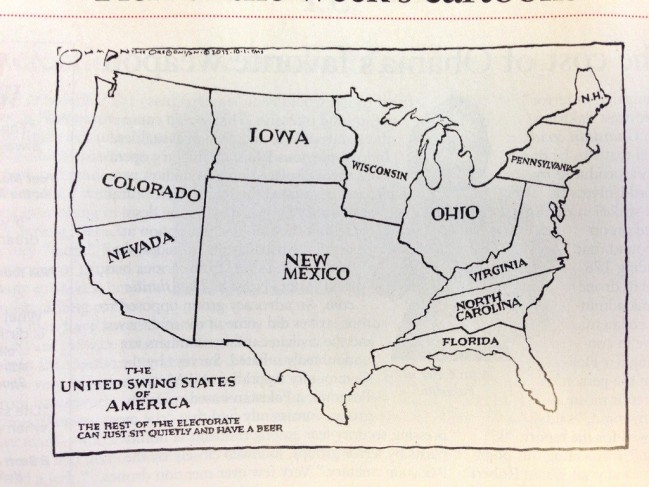Frank Jacobs over at Strange Maps has found a timely reminder that shows the inordinate influence that a few voters in several crucial States have over the rest of us.
[div class=attrib]From Strange Maps:[end-div]
At the stroke of midnight on November 6th, the 21 registered voters of Dixville Notch, gathering in the wood-panelled Ballot Room of the Balsams Grand Resort Hotel, will have just one minute to cast their vote. Speed is of the essence, if the tiny New Hampshire town is to uphold its reputation (est. 1960) as the first place to declare its results in the US presidential elections.
Later that day, well over 200 million other American voters will face the same choice as the good folks of the Notch: returning Barack Obama to the White House for a second and final four-year term, or electing Mitt Romney as the 45th President of the United States.
The winner of that contest will not be determined by whoever wins a simple majority (i.e. 50% of all votes cast, plus at least one). Like many electoral processes across the world, the system to elect the next president of the United States is riddled with idiosyncrasies and peculiarities – the quadrennial quorum in Dixville Notch being just one example.
Even though most US Presidents have indeed gained office by winning the popular vote, but this is not always the case. What is needed, is winning the electoral vote. For the US presidential election is an indirect one: depending on the outcome in each of the 50 states, an Electoral College convenes in Washington DC to elect the President.
The total of 538 electors is distributed across the states in proportion to their population size, and is regularly adjusted to reflect increases or decreases. In 2008 Louisiana had 9 electors and South Carolina had 8; reflecting a relative population decrease, resp. increase, those numbers are now reversed.
Maine and Nebraska are the only states to assign their electors proportionally; the other 48 states (and DC) operate on the ABBA principle: however slight the majority of either candidate in any of those states, he would win all its electoral votes. This rather convoluted system underlines the fact that the US Presidential elections are the sum of 50, state-level contests. It also brings into focus that some states are more important than others.
Obviously, in this system the more populous states carry much more weight than the emptier ones. Consider the map of the United States, and focus on the 17 states west of the straight-ish line of state borders from North Dakota-Minnesota in the north to Texas-Louisiana in the south. Just two states – Texas and California – outweigh the electoral votes of the 15 others.
So presidential candidates concentrate their efforts on the states where they can hope to gain the greatest advantage. This excludes the fairly large number of states that are solidly ‘blue’ (i.e. Democratic) or ‘red’ (Republican). Texas, for example, is reliably Republican, while California can be expected to fall in the Democratic column.
[div class=attrib]Read the entire article after the jump.[end-div]
[div class=attrib]Map courtesy of Strange Maps / Big Think.[end-div]

